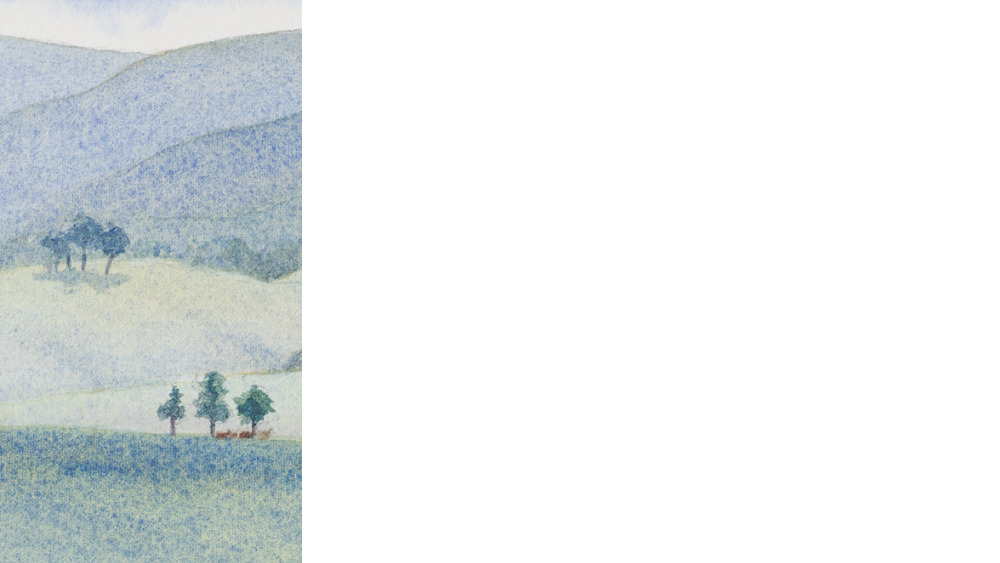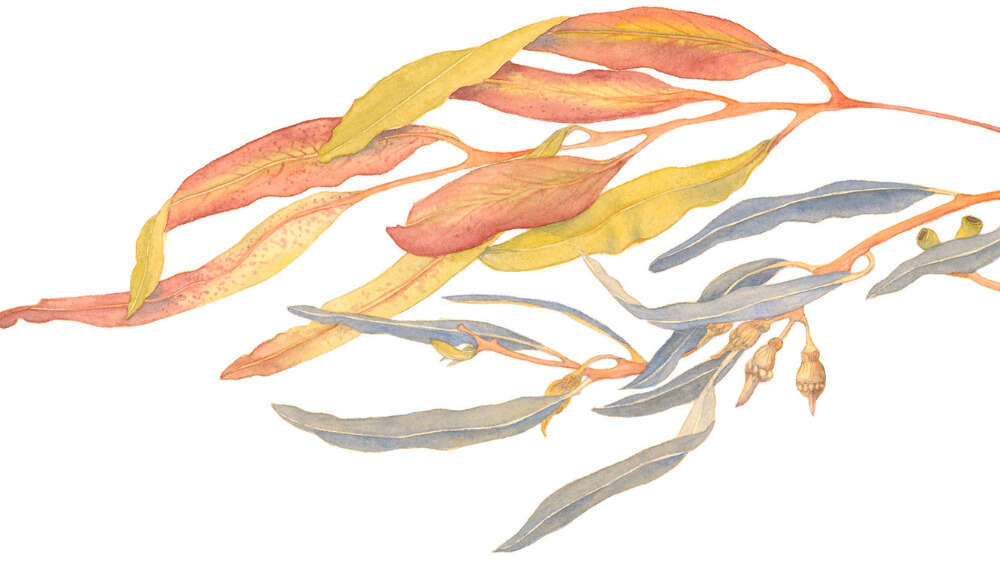Fiona Pfennigwerth’s pilgrimage to joining the long procession of illuminators (or limners) of Scripture began in the late ’70s, when she reluctantly joined her husband Ross at the annual conference of the Australian Fellowship of Evangelical Students (AFES).
The ostensible drawcard was teaching by the famous English theologian John Stott on Ephesians. But while that was enriching, what proved life-changing for Fiona were the sessions on Manuscript Discovery looking at the book of Mark.
“And all of the discussions at every mealtime were about Mark,” she recalls.
“It was really funny. John was there, gave brilliant talks, but all the debate was what people were learning, what they discovered for themselves. Looking at the Bible holistically was absolutely revolutionary. I’d never experienced such a thing.”
The starting point in Manuscript Discovery (MD) is having a Bible text without any subheadings or chapter and verse notations, or even paragraph and stanza divisions, all of which are recently added Western editorial comments. The manuscript becomes a continuous whole with page and line numbers but no preconceptions about where the different episodes are.
“It gave them confidence that, if I can relate to the Scripture directly, then I can relate to God more directly.” – Fiona Pfennigwerth
“It was very exciting because this was the first time that I read the Bible for myself and there was no middle man,” Fiona explains.
“I could meet the Lord through his Scriptures without an intermediary. I could meet its human author through his writing style. I could meet the text as a whole, crafted piece in the patterns of its writing.”
This was a radical departure from the evangelical approach of listening to Bible teachers and commentaries, and allowed readers to confidently discover a manuscript for themselves, discussing things such as how it fits together, what literary devices and conventions the author adopts and what they reveal about the author’s purposes and concerns.

Psalm 121a
In MD, the agenda is not to make “a short chapter that’s a chunk that can be preached on or whatever. You’re saying, how does the whole thing fit together?
“So we just got up and ran with it [the MD approach]. In all the groups in which we studied Bible books, people in that group realised that together, they could really work out 90 per cent of what that passage, what that book was about. It gave them confidence that, if I can relate to the Scripture directly, then I can relate to God more directly. So it had a huge impact on people’s faith.”
Fiona would cut and paste the manuscript of the book they had studied into a scroll, with or without sketches.
Over the next few years, Fiona and Ross ran MD studies at camps and weekly home groups, starting with Mark, then moving on to Luke, some of Paul’s letters, Ruth, Lamentations and the Psalms.
“When you get to a lot of the Hebrew Scriptures, they’re very tightly structured and most of them are symmetrical, where the first unit matches the last, the second episode matches the second last. So Ruth chapter one matches chapter four, and two matches three. But then you’ve got something like Lamentations, which is five chapters and it is paired – [you’ve got] one and five, two and four, then the central chapter. So it’s both symmetrical and concentric with the centre. And you see that pattern throughout Scripture,” she explains.
Sometimes, at the end of a series, Fiona would cut and paste the manuscript of the book they had studied into a scroll, with or without sketches. The aim was to highlight word patterns and the overall shape the group had discovered in the text.

Psalm 79 – Two Birds of Prey Fiona Pfennigwerth
“I did a mock-up of that with my little sketches on it and just showed the group and said this might help you understand what the purpose is if you’ve got the whole picture. I thought one day it’d be quite fun to do something more seriously, but it just became a bottom-drawer project.
“I was also doing paintings and putting them in exhibitions, but I wasn’t doing well because I didn’t fit the categories. You’re either traditional landscape, traditional still life or you were contemporary. And I just wanted to draw nature – decorative, if you like.
“One of the big gallery owners said, ‘Fiona, you’re not different enough,’ so I had this crisis of confidence. And one of my friends said to me, ‘Why don’t we go back to TAFE? Maybe we could reinvent ourselves.’”
“Theology and literature, nature and art embraced one another – I was home.”
But at TAFE, Fiona found herself in trouble again. The same criticism was made: her paintings were too ‘safe’, naturalistic and not self-expressive. She was not stretching herself.
“Then a friend from the TAFE class told me about an exhibition of Honours students in the Natural History Illustration course at the University of Newcastle. ‘That’s where you should be,’ the friend said.”
Fiona agreed, so she rang the university, spoke to the course convener and arranged a visit the next day.
“’Do a project, and write an essay about it,’ she explained of the program when we met. ‘And,’ with magnificent understatement, ‘by the way, there is some coursework.’ ‘What about an illustrated Bible manuscript?’ ‘Yes, and we start Monday.’”
So began Fiona’s formal journey to creating illuminated biblical manuscripts, beginning with Solomon’s Song of Song as her Honours project.
This manuscript had begun its life in a Bible study group with illustrations from the text – vineyards and pomegranates, lilies among brambles – and as the course progressed, Fiona looked at Australian equivalents of the book’s natural subjects. On a bush walk, she saw a pair of trees fused partially at their trunks, an image that created a connection with the Song’s opening line: “Let him kiss me with the kisses of his mouth.”

Fiona Pfennigwerth
“Theology and literature, nature and art embraced one another – I was home,” she commented.
“The first term, I read and reread The Song in MD form, scores of times. I marked and inwardly digested it. I made decisions on its shape and emphases, until I felt ready to consult the experts. There I discovered that none of them agreed with each other, or me. And I wrote up my findings. The next term, I designed my manuscript as a series of panels of text and illustration to form a scroll; I made preparatory sketches and a mock-up. Finally, I worked on finished paintings.
“As it happened, I had rough manuscripts of Ruth, Lamentations and Ecclesiastes, also developed out of informal Bible studies. With Esther and The Song, they form a set in the Hebrew Scriptures known as The Scrolls, read at five of the annual Jewish festivals. I continued into postgrad to produce the set, which eventually I self-published as The Scrolls Illuminated.
“The course emphasised the importance of habitat, which became my means of differentiating between the biblical texts, each illustration series in its own distinct setting. Habitat could also suggest the tenor of each writing, and echoing images suggest text shape.”
Fiona’s Psalms book was a five-year project with 250 drawings set out to help the reader understand how each Psalm is structured.
Finding a satisfactory layout for Ecclesiastes took far greater time and angst than the first three of her designs, and finding a habitat that reflected it – mist and chasing after wind?
And so on to The Gospel according to John; and more recently, The Book of Psalms Illuminated – each far longer in gestation than the previous ones, though knit together in the same process.
“For each habitat, I had a list of metaphors I was seeking to materialise, and on the road to it – Broken Hill, or Tasmania, or to the Kimberley – rehearsing what I could remember of the text. At the end of each day of one of those field trips, I would list photographs or sketches I’d made that would possibly satisfy one quest.”
As was the intention of illuminators embellishing Scripture before the printing press, Fiona sought to honour the Bible, interpret the stories and connect them to their own context.
“I am firstly about seeing the text: its underlying tenors and themes and shapes, and sharing that vision. The pictures accompanying it, being naturalistic, are recognisable and accessible, so that people see through them to the text, without needing a further layer of interpretation between them. They are unashamedly pretty, so people are drawn into the conversation between text and image. They are Australian, but timeless. Text and picture, each reflecting the creative artistry of our Lord in the physical and the Word, each complementing the other.”
Fiona’s Psalms book was a five-year project with 250 drawings set out to help the reader understand how each Psalm is structured.
“The illustrations are secondary to the layout of the text itself. They’re really just to make you want to sit with it,” she explains. “I want others to have the same excitement and connection to the Lord’s words and works”.
For more on Manuscript Discovery and Fiona’s work, visit fionapfennigwerth.info.
Email This Story
Why not send this to a friend?


